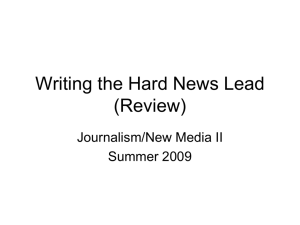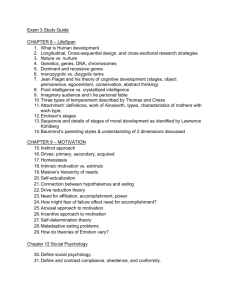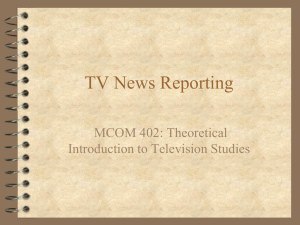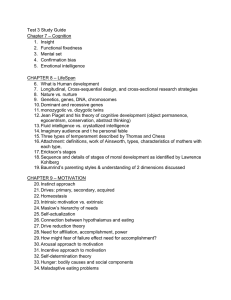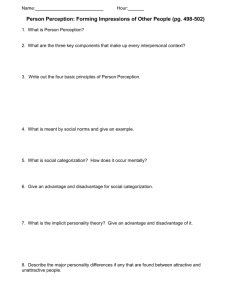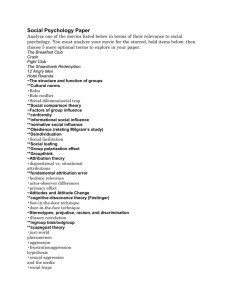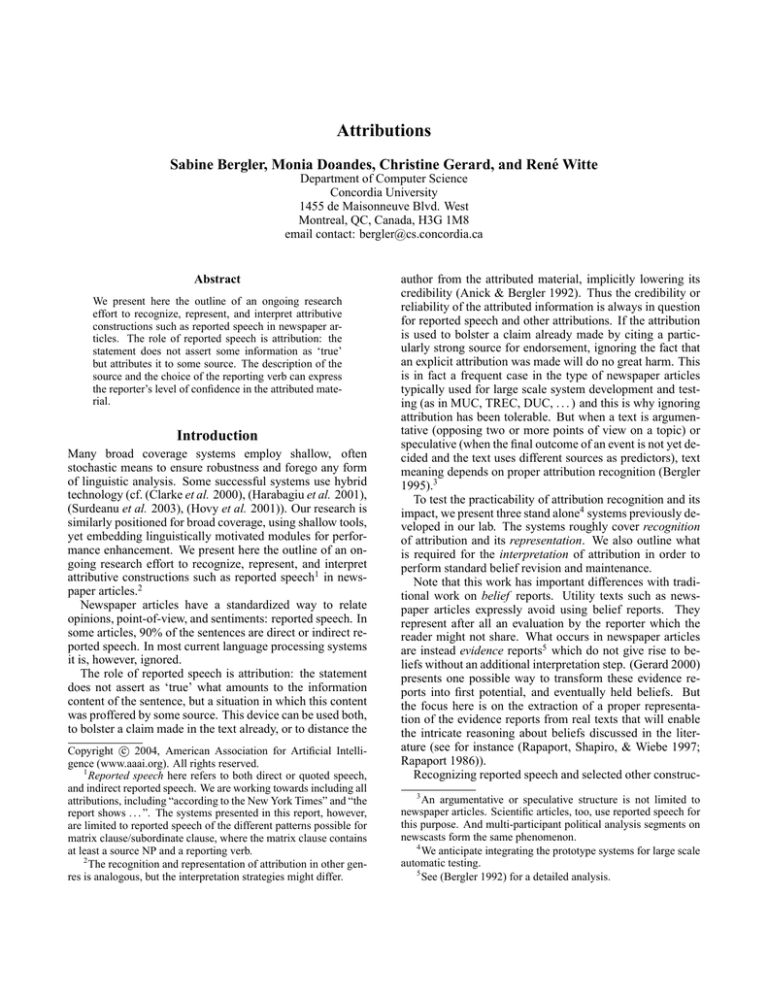
Attributions
Sabine Bergler, Monia Doandes, Christine Gerard, and René Witte
Department of Computer Science
Concordia University
1455 de Maisonneuve Blvd. West
Montreal, QC, Canada, H3G 1M8
email contact: bergler@cs.concordia.ca
Abstract
We present here the outline of an ongoing research
effort to recognize, represent, and interpret attributive
constructions such as reported speech in newspaper articles. The role of reported speech is attribution: the
statement does not assert some information as ‘true’
but attributes it to some source. The description of the
source and the choice of the reporting verb can express
the reporter’s level of confidence in the attributed material.
Introduction
Many broad coverage systems employ shallow, often
stochastic means to ensure robustness and forego any form
of linguistic analysis. Some successful systems use hybrid
technology (cf. (Clarke et al. 2000), (Harabagiu et al. 2001),
(Surdeanu et al. 2003), (Hovy et al. 2001)). Our research is
similarly positioned for broad coverage, using shallow tools,
yet embedding linguistically motivated modules for performance enhancement. We present here the outline of an ongoing research effort to recognize, represent, and interpret
attributive constructions such as reported speech1 in newspaper articles.2
Newspaper articles have a standardized way to relate
opinions, point-of-view, and sentiments: reported speech. In
some articles, 90% of the sentences are direct or indirect reported speech. In most current language processing systems
it is, however, ignored.
The role of reported speech is attribution: the statement
does not assert as ‘true’ what amounts to the information
content of the sentence, but a situation in which this content
was proffered by some source. This device can be used both,
to bolster a claim made in the text already, or to distance the
c 2004, American Association for Artificial IntelliCopyright gence (www.aaai.org). All rights reserved.
1
Reported speech here refers to both direct or quoted speech,
and indirect reported speech. We are working towards including all
attributions, including “according to the New York Times” and “the
report shows . . . ”. The systems presented in this report, however,
are limited to reported speech of the different patterns possible for
matrix clause/subordinate clause, where the matrix clause contains
at least a source NP and a reporting verb.
2
The recognition and representation of attribution in other genres is analogous, but the interpretation strategies might differ.
author from the attributed material, implicitly lowering its
credibility (Anick & Bergler 1992). Thus the credibility or
reliability of the attributed information is always in question
for reported speech and other attributions. If the attribution
is used to bolster a claim already made by citing a particularly strong source for endorsement, ignoring the fact that
an explicit attribution was made will do no great harm. This
is in fact a frequent case in the type of newspaper articles
typically used for large scale system development and testing (as in MUC, TREC, DUC, . . . ) and this is why ignoring
attribution has been tolerable. But when a text is argumentative (opposing two or more points of view on a topic) or
speculative (when the final outcome of an event is not yet decided and the text uses different sources as predictors), text
meaning depends on proper attribution recognition (Bergler
1995).3
To test the practicability of attribution recognition and its
impact, we present three stand alone4 systems previously developed in our lab. The systems roughly cover recognition
of attribution and its representation. We also outline what
is required for the interpretation of attribution in order to
perform standard belief revision and maintenance.
Note that this work has important differences with traditional work on belief reports. Utility texts such as newspaper articles expressly avoid using belief reports. They
represent after all an evaluation by the reporter which the
reader might not share. What occurs in newspaper articles
are instead evidence reports5 which do not give rise to beliefs without an additional interpretation step. (Gerard 2000)
presents one possible way to transform these evidence reports into first potential, and eventually held beliefs. But
the focus here is on the extraction of a proper representation of the evidence reports from real texts that will enable
the intricate reasoning about beliefs discussed in the literature (see for instance (Rapaport, Shapiro, & Wiebe 1997;
Rapaport 1986)).
Recognizing reported speech and selected other construc3
An argumentative or speculative structure is not limited to
newspaper articles. Scientific articles, too, use reported speech for
this purpose. And multi-participant political analysis segments on
newscasts form the same phenomenon.
4
We anticipate integrating the prototype systems for large scale
automatic testing.
5
See (Bergler 1992) for a detailed analysis.
tions is based on a reported speech recognition and representation system (Doandes 2003). Interpretation will be based
on an exploratory prototype of belief acquisition called Percolator (Gerard 2000). The bridge between them is the
fuzzy-set based coreference resolution system Fuzzy-ERS
(Witte & Bergler 2003). We describe the modules in the following sections on an example text presented in Figure 1.
Politics & Policy: Democrats Plan Tactic to Block TaxCut Vote
Threat of Senate Filibuster Could Indefinitely Delay
Capital-Gains Package
(S1 ) Democratic leaders have bottled up President Bush’s
capital-gains tax cut in the Senate and may be able to prevent
a vote on the issue indefinitely.
(S2 ) Yesterday, Sen. Packwood acknowledged, ”We don’t
have the votes for cloture today.”
(S3 ) The Republicans contend that they can garner a majority
in the 100-member Senate for a capital-gains tax cut. (S4 )
They accuse the Democrats of unfairly using Senate rules to
erect a 60-vote hurdle.
(S5 ) Democrats asserted that the proposal, which also would
create a new type of individual retirement account, was
fraught with budget gimmickry that would lose billions of
dollars in the long run.
Figure 1: Adapted from Jeffrey H. Birnbaum, The Wall
Street Journal, 10/27/89
Recognizing Reported Speech
Doandes (Doandes 2003) developed a context-free grammar
to chunk contiguous verb groups and extracts grammatical
information from the chunks (tense, aspect, modality, polarity). Using a list of possible6 reported speech indicating verbs, she then applies the known patterns for reported
speech (Quirk et al. 1985) to separate the reporting clause
from the reported material.
The development was done on 65,739 sentences from the
Wall Street Journal, testing on 2404 sentences taken mainly
from the Wall Street Journal, with a few articles from the
DUC 2003 corpus. 513 occurrences of reported speech were
found, which makes for a precision of 98.65% and a recall
of 63%.
Recall problems are linked to tagging errors (a basic version of the Brill tagger was used), an incomplete list of reported speech verbs, the chunking process (the NP chunker
occasinally splits heavy NPs into several smaller chunks,
thus obfuscating the reported speech pattern), and the fact
that the chunker used a chart parser which returned the first
parse tree according to some internal criterion, not necessarily the best.
Figure 2 shows the condensed version of the system’s output in the form of reported speech frames which are counted
as correct only if they fully match the hand annotated Gold
standard. Additional information in the matrix clause (so
called circumstantial information, such as time, place, manner adverbials or prepositional phrases) are sometimes not
6
No word sense disambiguation is attempted.
S2
textsource Sen. Packwood
textverb acknowledged
reported speech ‘We don’t have the votes for cloture
today.’
circumstantial Yesterday,
semantic dimensions EXPLICIT:yes
POLARITY:positive
SPEECHACT:inform
STRENGTH:high
S3
textsource The Republicans
textverb contend
reported speech they can garner a majority in the
100-member Senate for a capital-gains tax cut.
semantic dimensions EXPLICIT:yes
POLARITY:positive
SPEECHACT:inform
S4
textsource They
textverb accuse
reported speech the Democrats of unfairly using Senate
rules to erect a 60-vote hurdle.
semantic dimensions EXPLICIT:yes
POLARITY:positive
SPEECHACT:inform
S5
textsource Democrats
textverb asserted
reported speech the proposal, which also would create
a new type of individual retirement account, was fraught
with budget gimmickry that would lose billions of dollars
in the long run.
semantic dimensions EXPLICIT:yes
POLARITY:positive
SPEECHACT:inform
STRENGTH:high
Figure 2: Internal structure of the reported speech sentences
S2 –S5 .
parsed correctly. In this case, the frame is not considered
correct, even though the main aspects of the reported speech
are correctly analyzed. The implementation has a precision
of 88% on identifying reported speech and determining its
internal structure, its recall is 56%
Representation
The sentence-by-sentence representation of Figure 2 is of
course but a beginning. Even in our simple text we see that
the same source occurs twice (republicans, They), suggesting strongly that both sentences form a logical unit. The
basic frames for S3 and S4 should be merged into one larger
profile for that source (see (Bergler 1995) for more detail on
profiles and their use in text representation.).
The use of profiles is simple: profiles provide a partition
of the text according to the source of the information transmitted. Any evaluation of the reliability/credibility will thus
affect the entire set. Moreover, the set of sources in a text in
turn can influence the evaluation of their credibility: compare the status of Police Officer XYZ compared to the thief
(status: high reliability) or disciplinary commission (status:
neutral). We see that while we cannot reliably determine the
meaning of the text, organizational ontologies might provide
a first step towards these evaluations. Thus the basic frames
representing a single utterance should be grouped by coreference resolution on the source into profiles.
(Witte & Bergler 2003) describes coreference resolution of isolated NPs using fuzzy set theory to explicitly
model the inherent uncertainty in our heuristic-based, nonprobabilistic approach to coreference resolution. In short,
a coreference chain is represented as a fuzzy set mapping
all noun phrases in a text to the [0, 1]-interval, which represents the degree of membership of each NP in the coreference chain. For further processing a threshold value determines which NP is considered “in” and which not. These
coreference chains have been employed as the main criterion
for selecting NPs in a text summarization system (Bergler et
al. 2003). While the coreference chains are not always exact, they work best for named entities, which are the most
frequent source descriptions. This system groups S3 and S4
as having the same source.
Interpretation
While the proper representation of the argumentative or
speculative structure of a text is important by itself and can
directly be used for information retrieval and extraction, for
instance, it begs the question of how to interpret the attributions made. To this end, (Gerard 2000) developed a system
Percolator, extending the basic notions of (Wilks & Ballim 1991). While Wilks and Ballim were concerned with
the proper attribution of surmised beliefs to dialog partners,
Gerard used their representation scheme of nested beliefs
and introduced the notion of belief acquisition through percolation.
Our text would be translated into the nested structures of
Figure 37 based on the profile structure.
In this representation, each reported speech complement
is indexed by its Source-list. The Source-list holds the description of the source (as given in the subject noun phrase of
the matrix clause) and four evaluation features, which represent in turn: the reporter’s confidence in the source(s)8 ,
the reporter’s confidence in the reported information9 , the
reader’s confidence in the source10 , and the reader’s confidence in the reported information11 . Important here is the
7
In fact Figures 3 and 4 have been edited for display. Percolator uses a hand-crafted predicate argument structure representation
of the reported material, having been developed first. But little
rests on this point, since it is a feasibility study of the accumulation
of the Source-list information and its potential for interpretation,
which are not affected by the representation of the complement
clause.
8
as expressed by the lexicalization of the matrix clause’s subject
NP
9
as expressed by the lexicalization of the reporting verb
10
potentially from prior knowledge or beliefs
11
again, potentially from previous knowledge or beliefs
System believes
Reader believes
Reporter Jeffrey H. Birnbaum believes
Sen. Packwood said
[“We don’t have the votes for cloture today.”
Source-list(Sen. Packwood, h, n, n, n)]
Republicans said
[Republicans can garner a majority in the 100-member
Senate for a capital-gains tax cut.
Source-list(Republicans, n, n, n, n)]
[the Democrats are unfairly using Senate rules to
erect a 60-vote hurdle.
Source-list(Republicans, n, h, n, n)]
Democrats said
[the proposal, which also would create a new type of
individual retirement account, was fraught with
budget gimmickry that would lose billions of dollars
in the long run.
Source-list(Democrats, n, n, n, n)]
Figure 3: Percolator representation of the Profiles in Figure 2
translation of the strength feature of the reporting verb into
a credibility rating of the reported information: acknowledge
as a reporting verb here carries an implication that the information of the complement clause is negative for the subject.
If a source is reported to acknowledge information this has to
be rated as information of high reliability12 because sources
will not falsely make detrimental statements.
The Source-list pairs the reporter’s apparent evaluation of
the source and the reported information from lexical semantics with the reader’s evaluation of the source and the reported information. This reflects a reader’s ability to immediately discount the reporter’s apparent evaluation based
on previous knowledge or on previous beliefs (about the reporter, the source, or the information). But a reader with no
relevant previous beliefs has to rely solely on the intrinsic
evaluation of the reporter.
Percolator transforms this representation in several steps
by pulling information from nested contexts into their surrounding contexts (a process called “percolation” by (Wilks
& Ballim 1991)). In every step the source list grows to reflect the nesting that has been lost, thus making explicit the
path of attribution. Gerard showed with several examples
that an extension of Wilks’ and Ballim’s percolation mechanism allows to properly combine subjective evaluations of
each level of attribution. But the representation of (Wilks
& Ballim 1991) was based on beliefs, so Gerard introduced
the notion of a potential belief, defined as information that
might or might not turn into a held belief given further evidence. This reflects a reader’s ability to accommodate contradictory information: having read an article that presents
two contradictory theories, one can argue both ways if one
has no own opinion on the matter until there is evidence that
“settles” the issue. This representational device allows to delay the decision as to whether information is believed until a
certain threshold of comfort is reached. The text here would
12
Possible values for the prototype were high, neutral, and low.
System believes
Reader believes
—
Reader potentially believes
[“We don’t have the votes for cloture today.”
Source-list(Sen. Packwood, Reporter Jeffrey H. Birnbaum, h, n, n, n)]
[Republicans can garner a majority in the 100-member
Senate for a capital-gains tax cut.
Source-list(Republicans, Reporter Jeffrey H. Birnbaum, n, n, n, n)]
[the Democrats are unfairly using Senate rules to
erect a 60-vote hurdle.
Source-list(Republicans, Reporter Jeffrey H. Birnbaum, n, h, n, n)]
[the proposal, which also would create a new type of
individual retirement account, was fraught with
budget gimmickry that would lose billions of dollars
in the long run.
Source-list(Democrats, Reporter Jeffrey H. Birnbaum, n, n, n, n)]
Figure 4: Final Percolator structure of Text 1 in the case
where the reader has no prior knowledge or beliefs.
be transformed into a structure as given in Figure 4.
Conclusion
Attribution is a phenomenon of great interest and a principled treatment is important beyond the realm of newspaper articles. We contend that the way natural language has
evolved to reflect a culture’s understanding of attribution13
can serve as a guide to a principled representation that can
form the basis for a belief revision or maintenance system.
We have distilled three major steps for this process: recognition, representation, and interpretation. Here we have only
been able to hint at how each step might be performed. We
will integrate the individual modules into an attribution resolution module, which will provide a test bed for two different kinds of experiments: without taking the interpretations
computed by Percolator into account we will measure the
usefulness of representing attributions and the argumentative or speculative structure of a text explicitly for Question Answering, Summarization, and Information Extraction. With the Percolator output we will be able to determine experimentally exactly what the semantic contribution
of different lexical items is on text comprehension and belief
acquisition.
Acknowledgments
Frank Rudzicz was instrumental in setting up Doandes’ environment. This work was funded in part by NSERC.
References
Anick, P., and Bergler, S. 1992. Lexical structures for linguistic inference. In Pustejovsky, J., and Bergler, S., eds.,
Lexical Semantics and Knowledge Representation. Berlin:
Springer Verlag. 121–135.
13
See, for instance, Native American languages which grammaticalize attribution.
Bergler, S.; Witte, R.; Khalife, M.; Li, Z.; and Rudzicz, F. 2003. Using knowledge-poor coreference resolution for text summarization. In On-line Proceedings of the Workshop on Text Summarization, Document
Understanding Conference (DUC 2003). http://wwwnlpir.nist.gov/projects/duc/pubs.html.
Bergler, S. 1992. Evidential Analysis of Reported Speech.
Ph.D. Dissertation, Brandeis University.
Bergler, S. 1995. From lexical semantics to text analysis. In Saint-Dizier, P., and Viegas, E., eds., Computational
Lexical Semantics. Cambridge, UK: Cambridge University
Press.
Clarke, C.; Cormack, G.; Kisman, D.; and Lynam, T.
2000. Question answering by passage selection. In Proceedings of the Ninth Text REtrieval Conference (TREC-9),
Gaithersburg, Maryland.
Doandes, M. 2003. Profiling for belief acquisition from
reported speech. Master’s thesis, Concordia University,
Montreal, Canada.
Gerard, C. 2000. Modelling readers of news articles using nested beliefs. Master’s thesis, Concordia University,
Montreal, Canada.
Harabagiu, S.; Moldovan, D.; Pasca, M.; Mihalcea, R.;
Surdeanu, M.; Bunescu, R.; Girju, R.; Rus, V.; and
Morarescu, P. 2001. The role of lexico-semantic feedback in open-domain textual question-answering. In Proceedings of the 39th Annual Meeting of the Association for
Computational Linguistics (ACL-2001), Toulouse France,
274–281.
Hovy, E.; Gerber, L.; Hermjakob, U.; Lin, C.-Y.; and
Ravichandran, D. 2001. Toward semantics-based answer
pinpointing. In Proceedings of the DARPA Human Language Technology Conference (HLT), San Diego, CA.
Quirk, R.; Greenbaum, S.; Leech, G.; and Svartvik, J.
1985. A Comprehensive Grammar of the English Language. London: Longman.
Rapaport, W. J.; Shapiro, S. C.; and Wiebe, J. 1997.
Quasi-indexicals and knowledge reports. Cognitive Science 21(1):63–107.
Rapaport, W. J. 1986. Logical foundations for belief representation. Cognitive Science 10:371–422.
Surdeanu, M.; Harabagiu, S.; Williams, J.; and Aarseth, P.
2003. Using predicate-argument structures for information
extraction. In Proceedings of the 41st Annual Meeting of
the Association for Computational Linguistics (ACL 2003),
Sapporo, Japan, 8–15.
Wilks, Y., and Ballim, A. 1991. Artificial Believers. Norwood, NJ: Erlbaum.
Witte, R., and Bergler, S. 2003. Fuzzy coreference resolution for summarization. In Proceedings of the International
Symposium on Reference Resolution and Its Applications
to Question Answering and Summarization (ARQAS 2003),
43–50.


